China's Global Ascendancy: Power, Strategy, and Challenges
Revision Note for Module 26: China’s Step Forward into the World
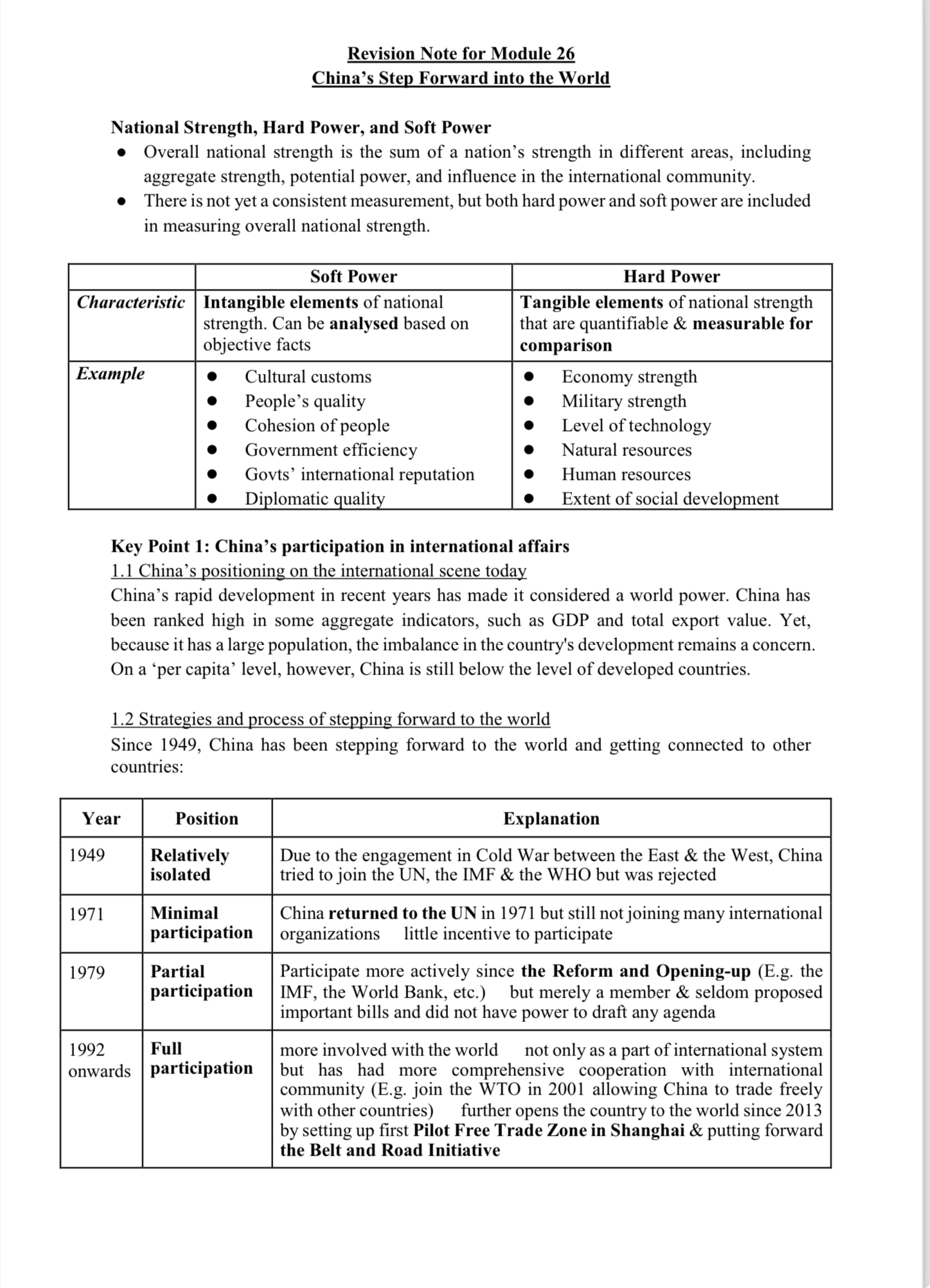
National Strength: Hard Power and Soft Power
- Overall National Strength: Sum of a nation’s strength in various areas including aggregate strength, potential power, and influence in the international community.
- Measurement: There's no consistent measurement system, but both hard power and soft power are vital for assessing national strength.
Comparison of Soft Power and Hard Power
| Soft Power | Hard Power |
|---|---|
| Characteristic | Intangible elements of national strength that can be analyzed based on objective facts. |
| Examples | - Cultural customs |
| - People’s quality | |
| - Cohesion of people | |
| - Government efficiency | |
| - Governments’ international reputation | |
| - Diplomatic quality |
Key Point 1: China’s Participation in International Affairs
1.1 China’s Positioning on the International Scene Today
- Rapid Development: China has made significant strides and is regarded as a world power, ranking high in indicators like GDP and total export value.
- Per Capita Concerns: Despite large aggregate figures, China’s per capita metrics are still below those of developed nations due to its vast population.
1.2 Strategies and Process of Stepping Forward to the World
Since 1949, China has been advancing its international presence and connectivity with other countries.
| Year | Position | Explanation |
|---|---|---|
| 1949 | Relatively Isolated | Engaged in Cold War; attempts to join UN, IMF, and WHO were rejected. |
| 1971 | Minimal Participation | Returned to the UN but limited participation in other international organizations. |
| 1979 | Partial Participation | Became more active post-Reform and Opening-up; joined organizations like the IMF and World Bank, but was a passive member. |
| 1992 onwards | Full Participation | Increased involvement in global affairs; established the first Pilot Free Trade Zone in Shanghai and initiated the Belt and Road Initiative. |
Additional Insights
- Soft Power: Enhances a country's ability to influence others through attraction (culture, values, policies) rather than coercion.
- Hard Power: Directly related to a nation's military and economic capabilities, often measured through tangible metrics.
- Belt and Road Initiative: A global development strategy adopted by China to enhance regional connectivity and embrace a brighter economic future by building infrastructure and broadening trade links.
Extended readings:
Pros and Cons of Joining the WTO for China
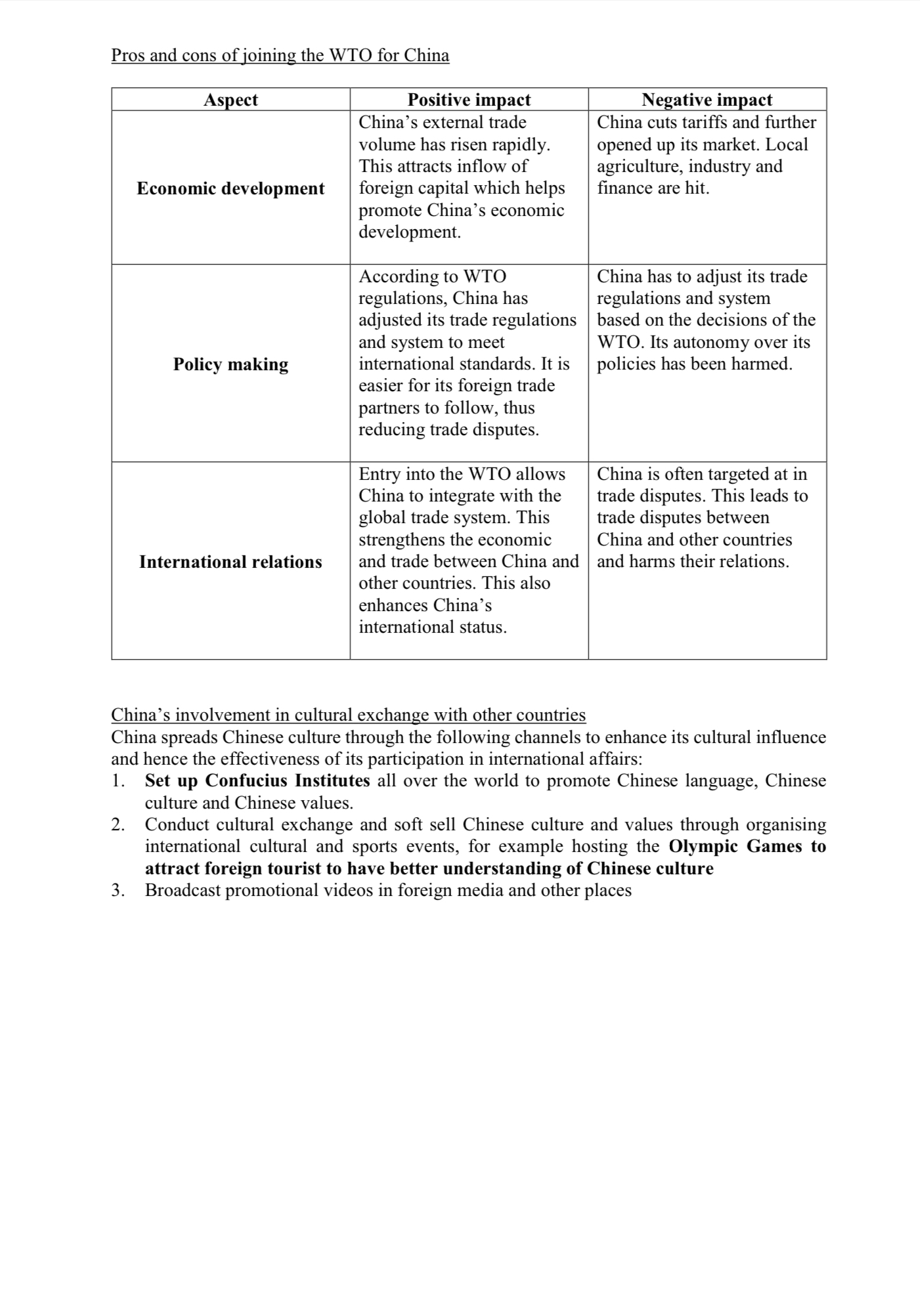
Economic Development
- Positive Impact: China's external trade volume has risen rapidly, attracting an inflow of foreign capital which promotes economic development.
- Insight: Increased trade often leads to greater market participation and investment opportunities, boosting various sectors in the economy.
- Negative Impact: China cuts tariffs and further opens up its market, which can adversely affect local agriculture, industry, and finance sectors.
- Additional Information: Tariff reductions can lead to increased competition from foreign products, potentially harming domestic industries.
Policy Making
- Positive Impact: According to WTO regulations, China has adjusted its trade regulations and system to align with international standards, making it easier for foreign trade partners to follow, thereby reducing trade disputes.
- Insight: Standardization in trade norms can enhance trade relations and minimize misunderstandings with international partners.
- Negative Impact: China’s autonomy is affected as it has to adjust its trade regulations based on WTO decisions, limiting its independent policy-making.
- Example: This can lead to conflicts in adapting domestic policies that may not align with international commitments.
International Relations
- Positive Impact: Joining the WTO allows China to integrate with the global trade system, strengthening economic ties and enhancing its international status.
- Insight: Participation in global trade enhances diplomatic relationships and fosters trade partnerships.
- Negative Impact: China is often targeted in trade disputes, which can strain relations with other countries.
- Additional Information: Trade disputes can lead to retaliatory measures, affecting bilateral trade agreements.
China’s Involvement in Cultural Exchange with Other Countries
China promotes its culture through various initiatives to enhance cultural influence and effectiveness in international affairs:
-
Confucius Institutes: Establishing institutions worldwide to promote the Chinese language and culture.
- Insight: These institutes serve as cultural ambassadors, offering language education and fostering cultural understanding.
-
Cultural Exchange Events: Conducting cultural exchanges and promoting Chinese culture through international events, such as the Olympic Games, aimed at attracting foreign tourists.
- Purpose: To improve global understanding of Chinese culture and values.
-
Media Promotion: Broadcasting promotional videos in foreign media to enhance visibility and cultural outreach.
- Insight: Effective media strategies can help showcase China's narrative to a global audience, shaping perceptions.
Extended readings:
Belt & Road Initiative
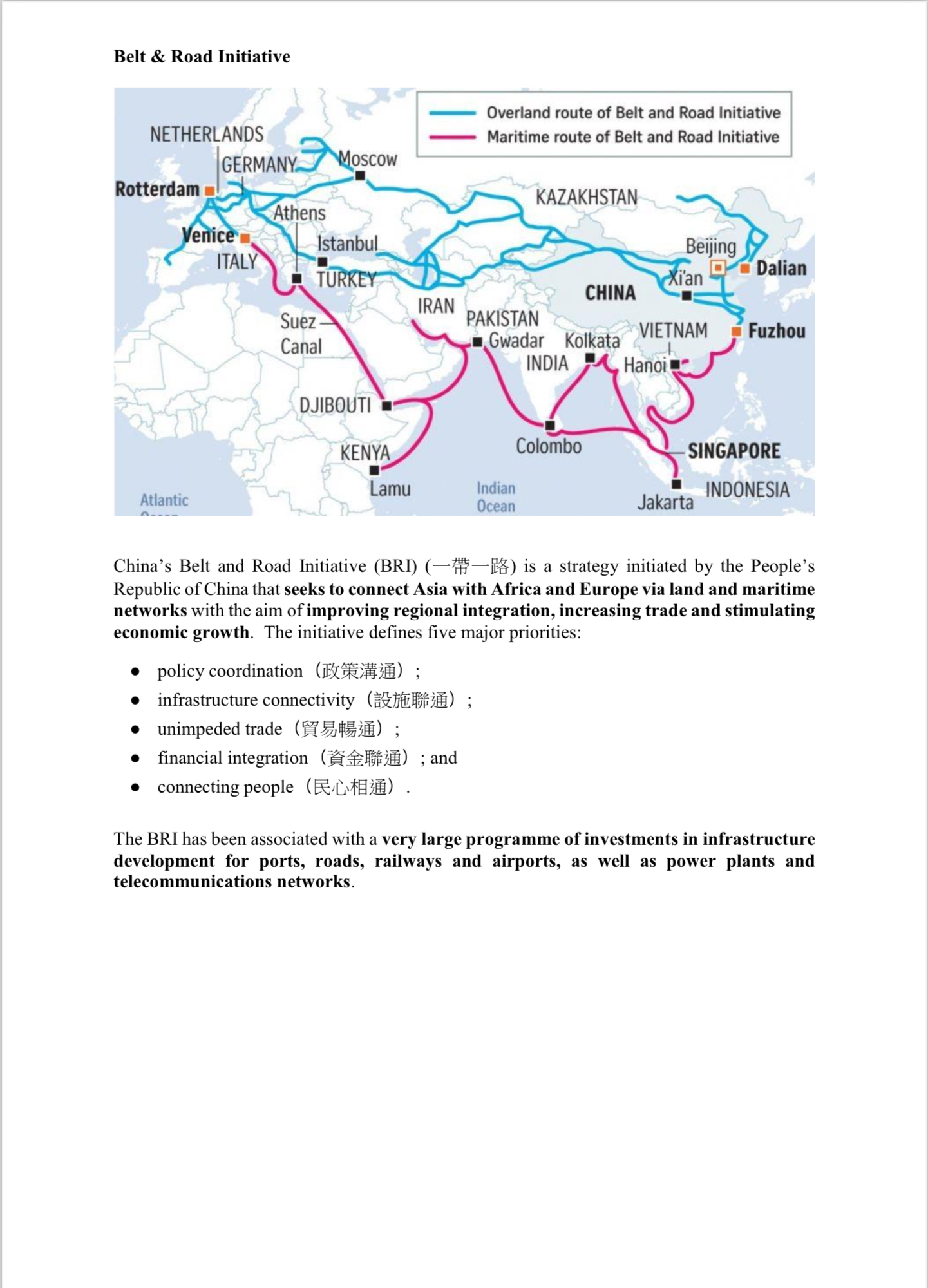
Overview
- Definition: China’s Belt and Road Initiative (BRI) (一带一路) is a strategy initiated by the People’s Republic of China aiming to connect Asia with Africa and Europe through land and maritime networks.
- Objective: The initiative focuses on improving regional integration, increasing trade, and stimulating economic growth.
Major Priorities
-
Policy Coordination (政策贯通)
- Ensures aligned policies among participating countries for smoother execution of initiatives and projects.
-
Infrastructure Connectivity (设施联通)
- Involves developing and enhancing infrastructure such as roads, railways, and ports to facilitate movement and trade across regions.
-
Unimpeded Trade (贸易畅通)
- Aims to remove barriers to trade and promote a more open trading environment among countries involved in the initiative.
-
Financial Integration (金融联通)
- Encourages financial cooperation to support investments and economic cooperation through the establishment of financial institutions.
-
Connecting People (民心相通)
- Focuses on cultural and social exchanges to foster understanding and relationships among diverse populations.
Investments
- The BRI has been linked to a substantial programme of investments aimed at:
- Development of infrastructure (ports, roads, railways, and airports).
- Establishment of energy projects (power plants).
- Expansion of telecommunications networks.
Conclusion
The Belt and Road Initiative represents a significant global development strategy involving multiple regions, with an emphasis on collaboration and shared economic growth. Understanding its components can help in analyzing the geopolitical landscape and economic relationships influenced by this initiative.
Extended readings:
Benefits and Concerns of the Belt and Road Initiative for China and Participating Countries
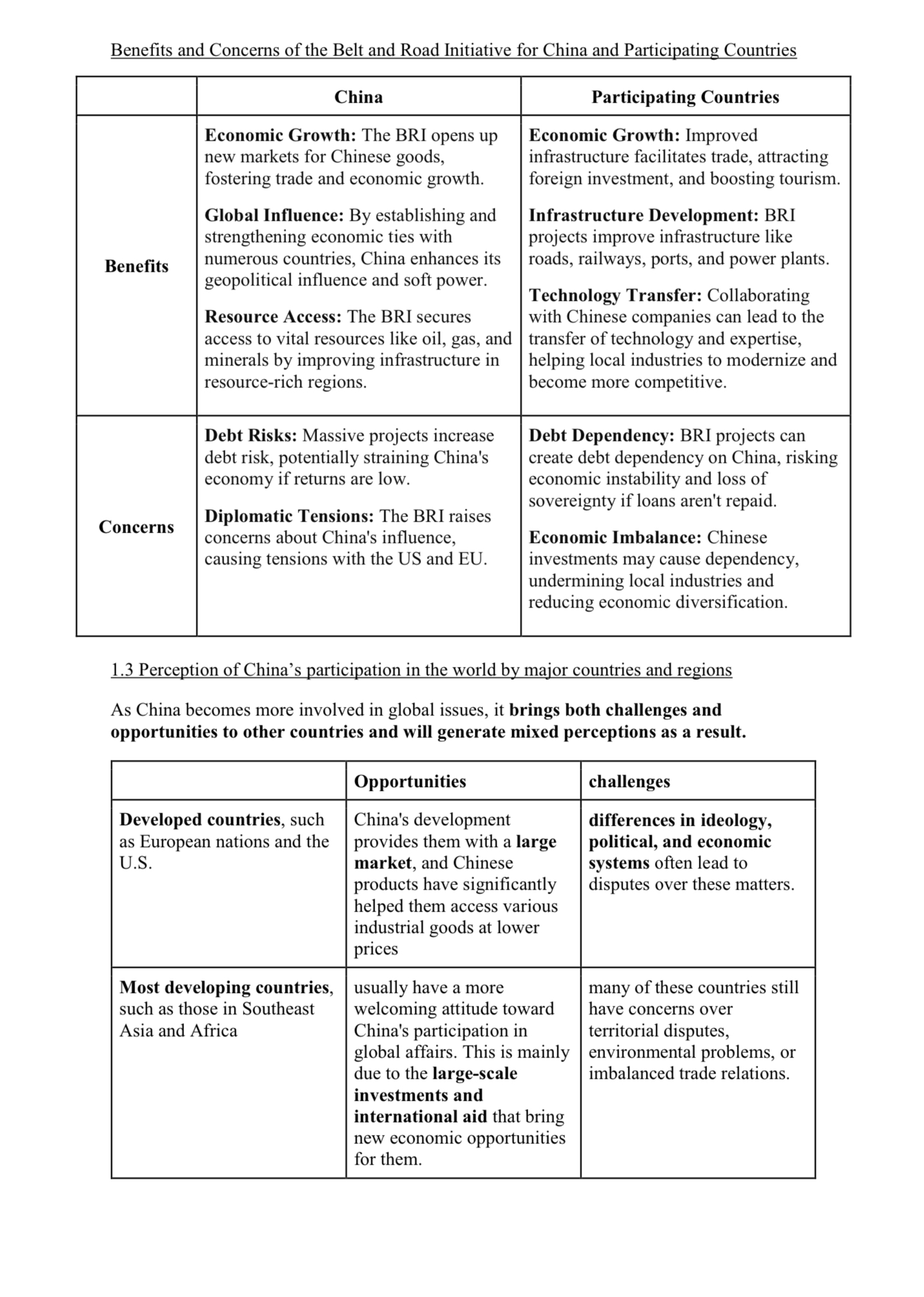
Benefits
China
-
Economic Growth:
- The Belt and Road Initiative (BRI) facilitates the opening of new markets for Chinese goods, thereby boosting trade and fostering economic growth.
-
Global Influence:
- By establishing and strengthening economic ties with various countries, China enhances its geopolitical influence and promotes its soft power.
-
Resource Access:
- The BRI allows China to secure vital resources, such as oil, gas, and minerals by improving infrastructure in resource-rich regions.
Participating Countries
-
Economic Growth:
- Improved infrastructure enhances trade opportunities, attracts foreign investment, and boosts tourism in participating countries.
-
Infrastructure Development:
- BRI projects facilitate the construction of essential infrastructure, including roads, railways, ports, and power plants.
-
Technology Transfer:
- Collaborating with Chinese companies can lead to the transfer of technology and expertise, aiding local industries in modernization and competitiveness.
Concerns
China
-
Debt Risks:
- Involvement in massive projects increases the risk of incurring debt, potentially straining China's economy if returns are low.
-
Diplomatic Tensions:
- The BRI has raised concerns regarding China's influence, which may lead to diplomatic tensions with Western countries like the US and EU.
Participating Countries
-
Debt Dependency:
- BRI projects can create dependency on China, posing risks of economic instability and loss of sovereignty if loans are not repaid.
-
Economic Imbalance:
- Chinese investments could lead to dependency issues, undermining local industries and reducing economic diversification.
1.3 Perception of China’s Participation in the World by Major Countries and Regions
As China's global involvement increases, it brings both challenges and opportunities for other nations, leading to mixed perceptions.
Opportunities
Developed Countries (e.g., European Nations, U.S.)
- China's development offers a large market, enabling access to a broad range of industrial goods at competitive prices.
Most Developing Countries (e.g., Southeast Asia, Africa)
- Generally adopt a more welcoming attitude towards China's participation due to large-scale investments and international aid, creating new economic opportunities.
Challenges
Developed Countries
- Differences in ideologies, political, and economic systems may lead to disputes over various matters.
Most Developing Countries
- Despite a generally welcoming stance, concerns persist regarding territorial disputes, environmental issues, or imbalanced trade relations.
Extended readings:
Challenges Faced by China
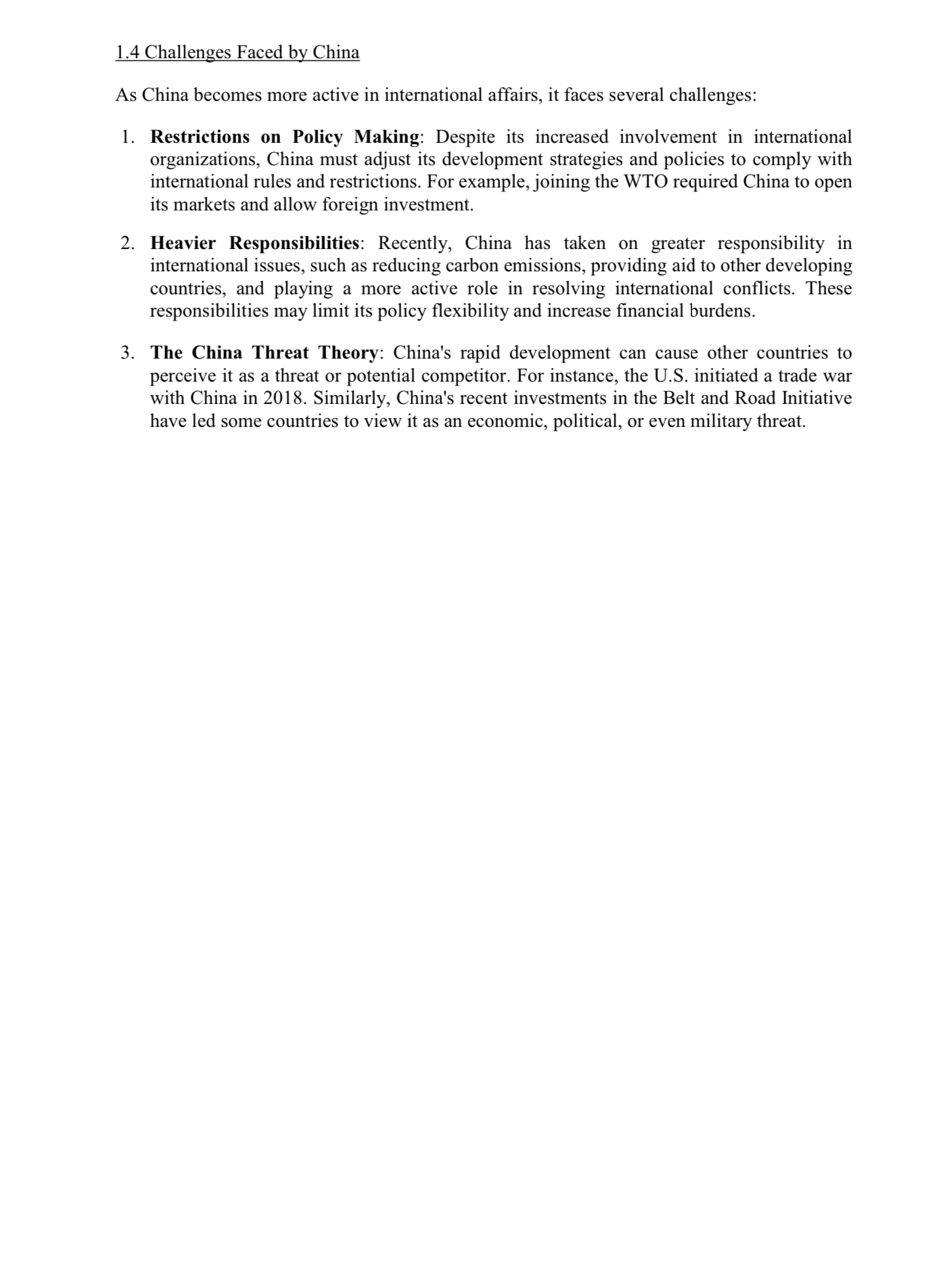
As China becomes more active in international affairs, it faces several challenges:
1. Restrictions on Policy Making
- Insight: China's increased participation in international organizations necessitates alignment with global standards.
- Explanation: The World Trade Organization (WTO) membership, for example, required China to liberalize its markets and allow foreign investments, which can constrain domestic policy options and economic strategies.
2. Heavier Responsibilities
- Insight: China is taking a more prominent role in addressing global issues.
- Explanation: Responsibilities include commitments to reduce carbon emissions and aid in international conflict resolution. While this enhances China's global standing, it may also reduce its policy flexibility and impose financial burdens.
3. The China Threat Theory
- Insight: China’s rapid growth is often perceived as a threat by other nations.
- Explanation: Instances like the U.S.-China trade war in 2018 exemplify concerns over economic competition. Additionally, China's investments in initiatives like the Belt and Road Initiative may be viewed by other countries as advancements in economic, political, or military power, leading to geopolitical tensions.
Extended readings: